System of E-commerce
VerifiedAdded on 2023/04/11
|11
|2248
|298
AI Summary
This document discusses the system of e-commerce and its impact on universities. It includes a SWOT analysis for offering courses to overseas students, recommendations for online learning, and Porter's Competitive Forces Model for the e-commerce industry. The document also provides recommendations for addressing issues such as culture and trust on the university's website and using online communication tools to reach the target audience.
Contribute Materials
Your contribution can guide someone’s learning journey. Share your
documents today.
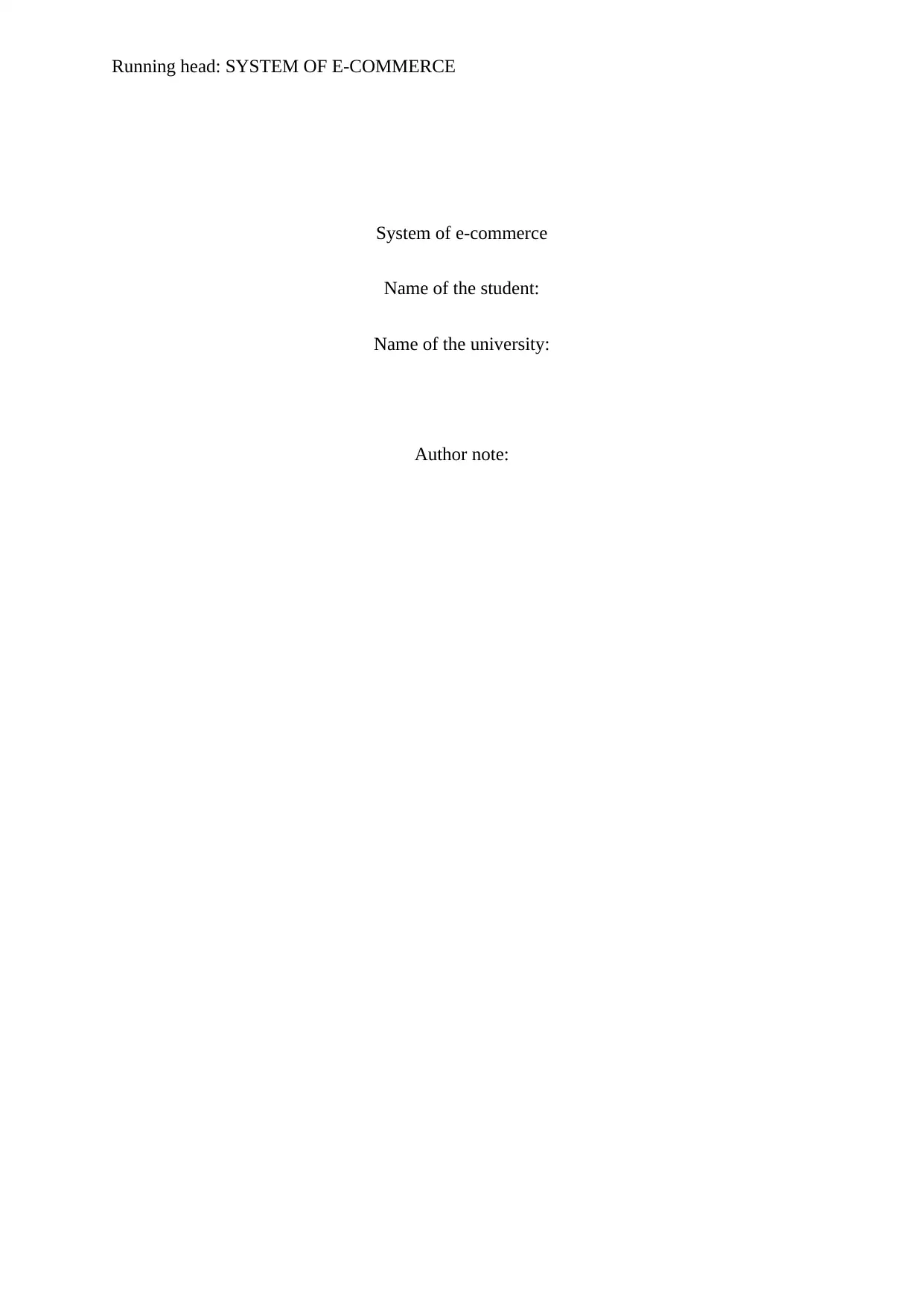
Running head: SYSTEM OF E-COMMERCE
System of e-commerce
Name of the student:
Name of the university:
Author note:
System of e-commerce
Name of the student:
Name of the university:
Author note:
Secure Best Marks with AI Grader
Need help grading? Try our AI Grader for instant feedback on your assignments.
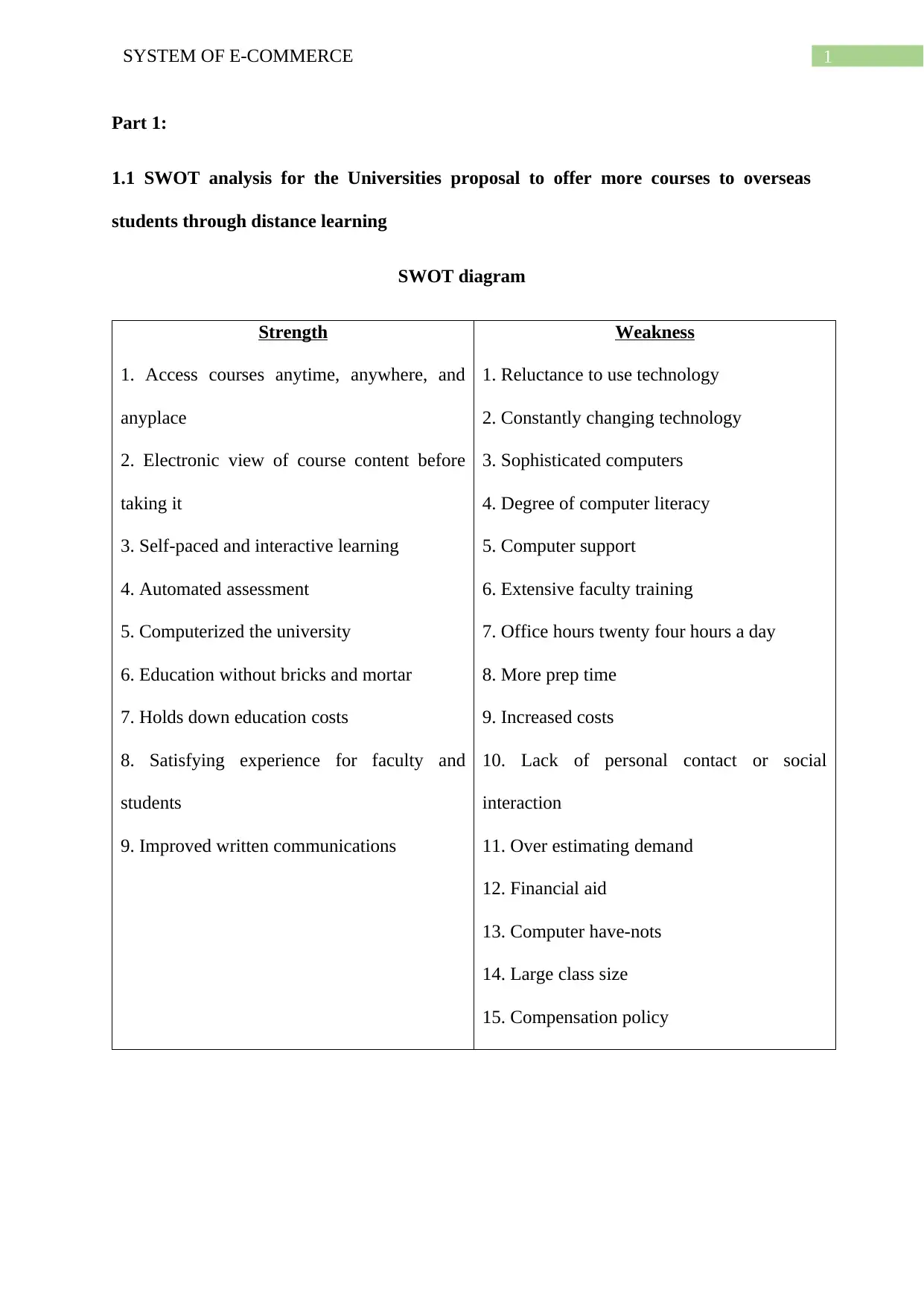
1SYSTEM OF E-COMMERCE
Part 1:
1.1 SWOT analysis for the Universities proposal to offer more courses to overseas
students through distance learning
SWOT diagram
Strength
1. Access courses anytime, anywhere, and
anyplace
2. Electronic view of course content before
taking it
3. Self-paced and interactive learning
4. Automated assessment
5. Computerized the university
6. Education without bricks and mortar
7. Holds down education costs
8. Satisfying experience for faculty and
students
9. Improved written communications
Weakness
1. Reluctance to use technology
2. Constantly changing technology
3. Sophisticated computers
4. Degree of computer literacy
5. Computer support
6. Extensive faculty training
7. Office hours twenty four hours a day
8. More prep time
9. Increased costs
10. Lack of personal contact or social
interaction
11. Over estimating demand
12. Financial aid
13. Computer have-nots
14. Large class size
15. Compensation policy
Part 1:
1.1 SWOT analysis for the Universities proposal to offer more courses to overseas
students through distance learning
SWOT diagram
Strength
1. Access courses anytime, anywhere, and
anyplace
2. Electronic view of course content before
taking it
3. Self-paced and interactive learning
4. Automated assessment
5. Computerized the university
6. Education without bricks and mortar
7. Holds down education costs
8. Satisfying experience for faculty and
students
9. Improved written communications
Weakness
1. Reluctance to use technology
2. Constantly changing technology
3. Sophisticated computers
4. Degree of computer literacy
5. Computer support
6. Extensive faculty training
7. Office hours twenty four hours a day
8. More prep time
9. Increased costs
10. Lack of personal contact or social
interaction
11. Over estimating demand
12. Financial aid
13. Computer have-nots
14. Large class size
15. Compensation policy
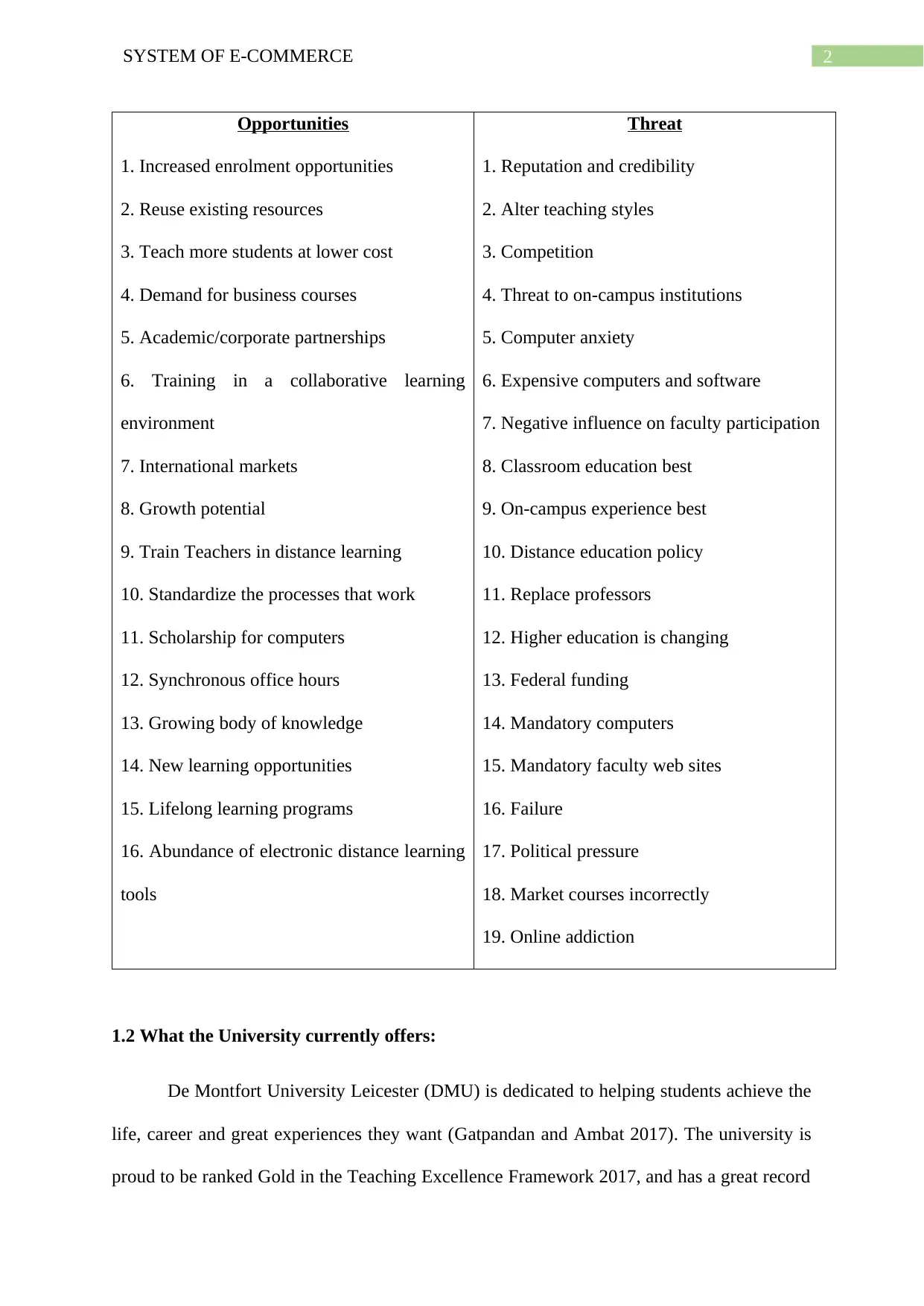
2SYSTEM OF E-COMMERCE
Opportunities
1. Increased enrolment opportunities
2. Reuse existing resources
3. Teach more students at lower cost
4. Demand for business courses
5. Academic/corporate partnerships
6. Training in a collaborative learning
environment
7. International markets
8. Growth potential
9. Train Teachers in distance learning
10. Standardize the processes that work
11. Scholarship for computers
12. Synchronous office hours
13. Growing body of knowledge
14. New learning opportunities
15. Lifelong learning programs
16. Abundance of electronic distance learning
tools
Threat
1. Reputation and credibility
2. Alter teaching styles
3. Competition
4. Threat to on-campus institutions
5. Computer anxiety
6. Expensive computers and software
7. Negative influence on faculty participation
8. Classroom education best
9. On-campus experience best
10. Distance education policy
11. Replace professors
12. Higher education is changing
13. Federal funding
14. Mandatory computers
15. Mandatory faculty web sites
16. Failure
17. Political pressure
18. Market courses incorrectly
19. Online addiction
1.2 What the University currently offers:
De Montfort University Leicester (DMU) is dedicated to helping students achieve the
life, career and great experiences they want (Gatpandan and Ambat 2017). The university is
proud to be ranked Gold in the Teaching Excellence Framework 2017, and has a great record
Opportunities
1. Increased enrolment opportunities
2. Reuse existing resources
3. Teach more students at lower cost
4. Demand for business courses
5. Academic/corporate partnerships
6. Training in a collaborative learning
environment
7. International markets
8. Growth potential
9. Train Teachers in distance learning
10. Standardize the processes that work
11. Scholarship for computers
12. Synchronous office hours
13. Growing body of knowledge
14. New learning opportunities
15. Lifelong learning programs
16. Abundance of electronic distance learning
tools
Threat
1. Reputation and credibility
2. Alter teaching styles
3. Competition
4. Threat to on-campus institutions
5. Computer anxiety
6. Expensive computers and software
7. Negative influence on faculty participation
8. Classroom education best
9. On-campus experience best
10. Distance education policy
11. Replace professors
12. Higher education is changing
13. Federal funding
14. Mandatory computers
15. Mandatory faculty web sites
16. Failure
17. Political pressure
18. Market courses incorrectly
19. Online addiction
1.2 What the University currently offers:
De Montfort University Leicester (DMU) is dedicated to helping students achieve the
life, career and great experiences they want (Gatpandan and Ambat 2017). The university is
proud to be ranked Gold in the Teaching Excellence Framework 2017, and has a great record
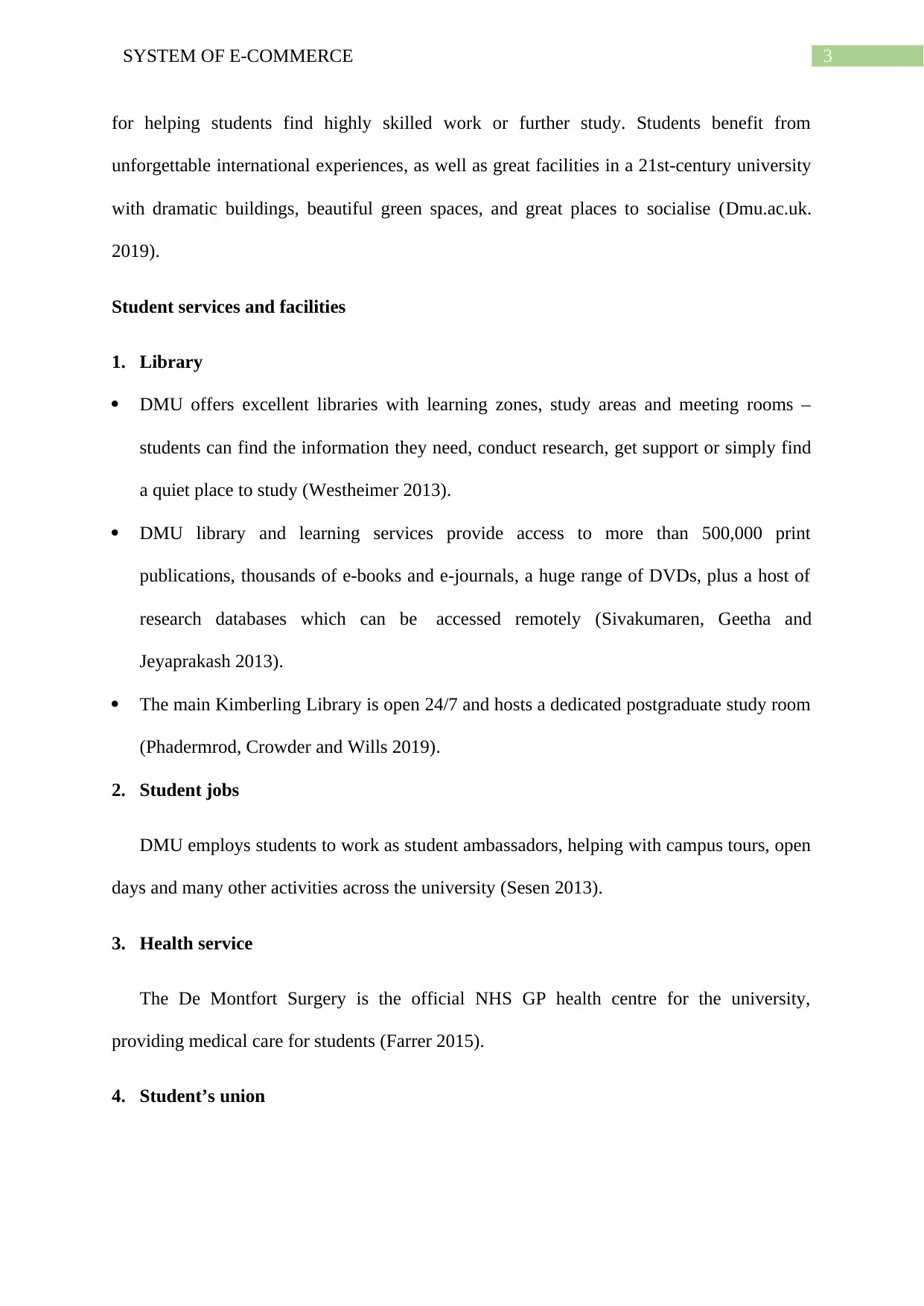
3SYSTEM OF E-COMMERCE
for helping students find highly skilled work or further study. Students benefit from
unforgettable international experiences, as well as great facilities in a 21st-century university
with dramatic buildings, beautiful green spaces, and great places to socialise (Dmu.ac.uk.
2019).
Student services and facilities
1. Library
DMU offers excellent libraries with learning zones, study areas and meeting rooms –
students can find the information they need, conduct research, get support or simply find
a quiet place to study (Westheimer 2013).
DMU library and learning services provide access to more than 500,000 print
publications, thousands of e-books and e-journals, a huge range of DVDs, plus a host of
research databases which can be accessed remotely (Sivakumaren, Geetha and
Jeyaprakash 2013).
The main Kimberling Library is open 24/7 and hosts a dedicated postgraduate study room
(Phadermrod, Crowder and Wills 2019).
2. Student jobs
DMU employs students to work as student ambassadors, helping with campus tours, open
days and many other activities across the university (Sesen 2013).
3. Health service
The De Montfort Surgery is the official NHS GP health centre for the university,
providing medical care for students (Farrer 2015).
4. Student’s union
for helping students find highly skilled work or further study. Students benefit from
unforgettable international experiences, as well as great facilities in a 21st-century university
with dramatic buildings, beautiful green spaces, and great places to socialise (Dmu.ac.uk.
2019).
Student services and facilities
1. Library
DMU offers excellent libraries with learning zones, study areas and meeting rooms –
students can find the information they need, conduct research, get support or simply find
a quiet place to study (Westheimer 2013).
DMU library and learning services provide access to more than 500,000 print
publications, thousands of e-books and e-journals, a huge range of DVDs, plus a host of
research databases which can be accessed remotely (Sivakumaren, Geetha and
Jeyaprakash 2013).
The main Kimberling Library is open 24/7 and hosts a dedicated postgraduate study room
(Phadermrod, Crowder and Wills 2019).
2. Student jobs
DMU employs students to work as student ambassadors, helping with campus tours, open
days and many other activities across the university (Sesen 2013).
3. Health service
The De Montfort Surgery is the official NHS GP health centre for the university,
providing medical care for students (Farrer 2015).
4. Student’s union
Secure Best Marks with AI Grader
Need help grading? Try our AI Grader for instant feedback on your assignments.
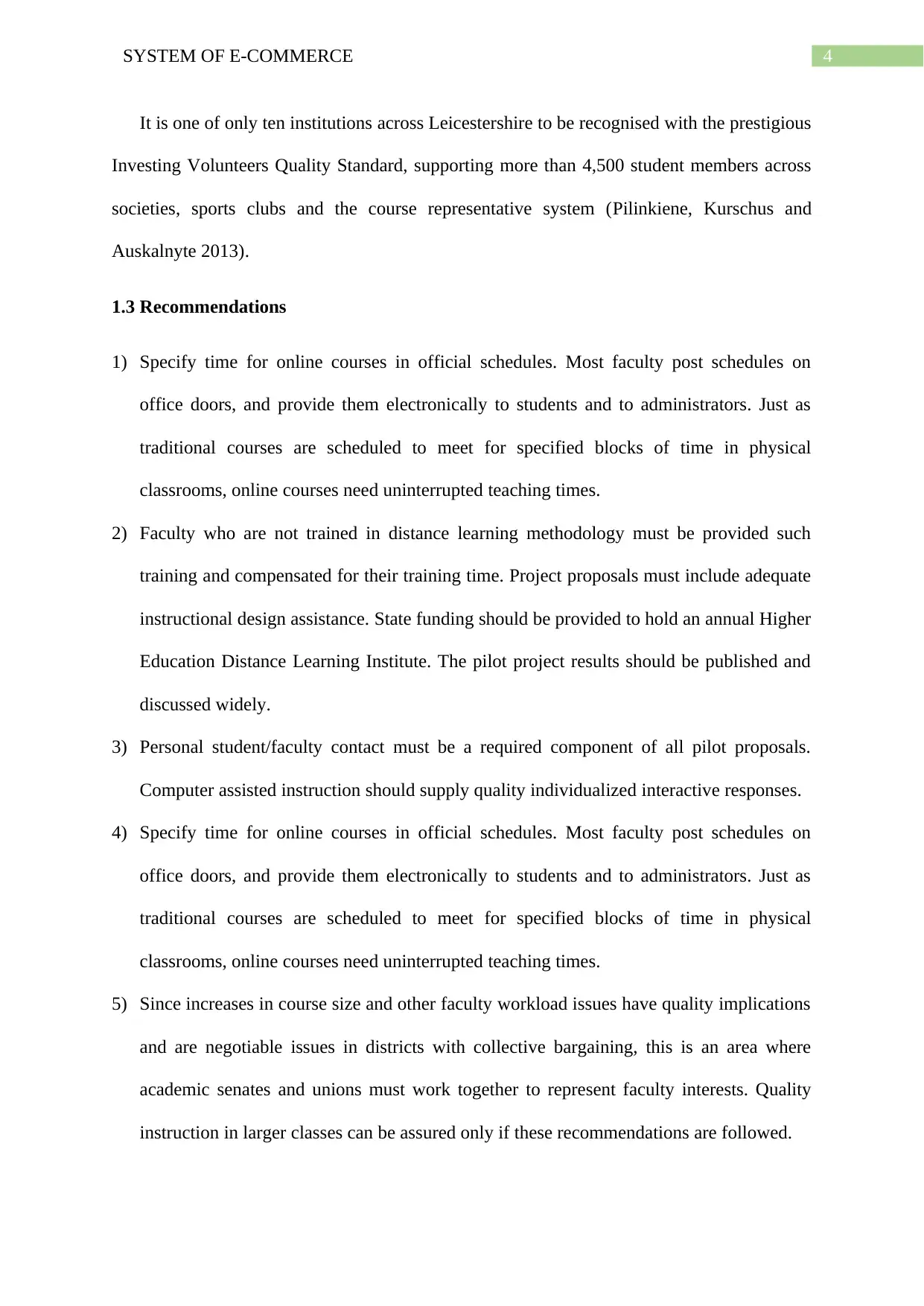
4SYSTEM OF E-COMMERCE
It is one of only ten institutions across Leicestershire to be recognised with the prestigious
Investing Volunteers Quality Standard, supporting more than 4,500 student members across
societies, sports clubs and the course representative system (Pilinkiene, Kurschus and
Auskalnyte 2013).
1.3 Recommendations
1) Specify time for online courses in official schedules. Most faculty post schedules on
office doors, and provide them electronically to students and to administrators. Just as
traditional courses are scheduled to meet for specified blocks of time in physical
classrooms, online courses need uninterrupted teaching times.
2) Faculty who are not trained in distance learning methodology must be provided such
training and compensated for their training time. Project proposals must include adequate
instructional design assistance. State funding should be provided to hold an annual Higher
Education Distance Learning Institute. The pilot project results should be published and
discussed widely.
3) Personal student/faculty contact must be a required component of all pilot proposals.
Computer assisted instruction should supply quality individualized interactive responses.
4) Specify time for online courses in official schedules. Most faculty post schedules on
office doors, and provide them electronically to students and to administrators. Just as
traditional courses are scheduled to meet for specified blocks of time in physical
classrooms, online courses need uninterrupted teaching times.
5) Since increases in course size and other faculty workload issues have quality implications
and are negotiable issues in districts with collective bargaining, this is an area where
academic senates and unions must work together to represent faculty interests. Quality
instruction in larger classes can be assured only if these recommendations are followed.
It is one of only ten institutions across Leicestershire to be recognised with the prestigious
Investing Volunteers Quality Standard, supporting more than 4,500 student members across
societies, sports clubs and the course representative system (Pilinkiene, Kurschus and
Auskalnyte 2013).
1.3 Recommendations
1) Specify time for online courses in official schedules. Most faculty post schedules on
office doors, and provide them electronically to students and to administrators. Just as
traditional courses are scheduled to meet for specified blocks of time in physical
classrooms, online courses need uninterrupted teaching times.
2) Faculty who are not trained in distance learning methodology must be provided such
training and compensated for their training time. Project proposals must include adequate
instructional design assistance. State funding should be provided to hold an annual Higher
Education Distance Learning Institute. The pilot project results should be published and
discussed widely.
3) Personal student/faculty contact must be a required component of all pilot proposals.
Computer assisted instruction should supply quality individualized interactive responses.
4) Specify time for online courses in official schedules. Most faculty post schedules on
office doors, and provide them electronically to students and to administrators. Just as
traditional courses are scheduled to meet for specified blocks of time in physical
classrooms, online courses need uninterrupted teaching times.
5) Since increases in course size and other faculty workload issues have quality implications
and are negotiable issues in districts with collective bargaining, this is an area where
academic senates and unions must work together to represent faculty interests. Quality
instruction in larger classes can be assured only if these recommendations are followed.
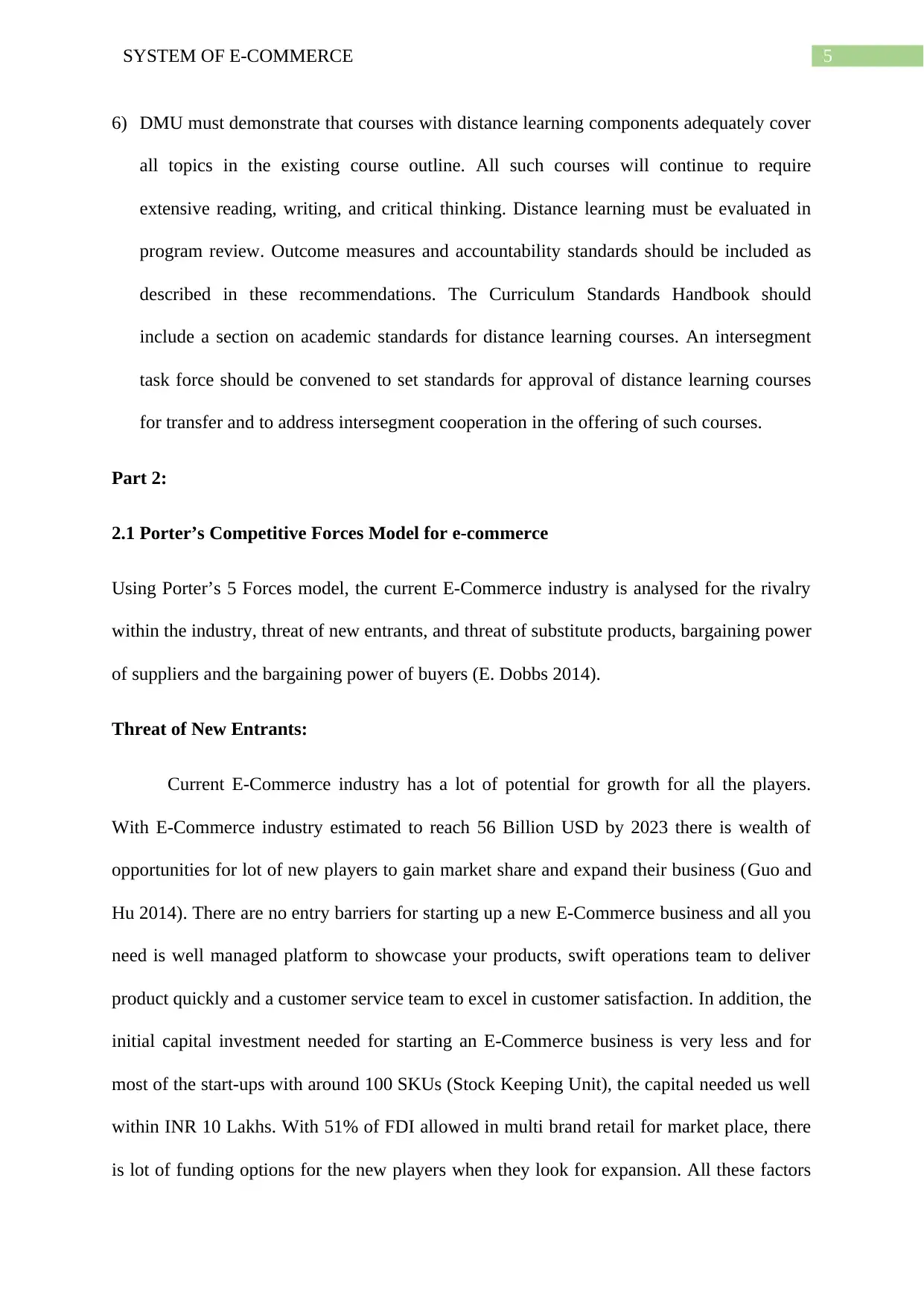
5SYSTEM OF E-COMMERCE
6) DMU must demonstrate that courses with distance learning components adequately cover
all topics in the existing course outline. All such courses will continue to require
extensive reading, writing, and critical thinking. Distance learning must be evaluated in
program review. Outcome measures and accountability standards should be included as
described in these recommendations. The Curriculum Standards Handbook should
include a section on academic standards for distance learning courses. An intersegment
task force should be convened to set standards for approval of distance learning courses
for transfer and to address intersegment cooperation in the offering of such courses.
Part 2:
2.1 Porter’s Competitive Forces Model for e-commerce
Using Porter’s 5 Forces model, the current E-Commerce industry is analysed for the rivalry
within the industry, threat of new entrants, and threat of substitute products, bargaining power
of suppliers and the bargaining power of buyers (E. Dobbs 2014).
Threat of New Entrants:
Current E-Commerce industry has a lot of potential for growth for all the players.
With E-Commerce industry estimated to reach 56 Billion USD by 2023 there is wealth of
opportunities for lot of new players to gain market share and expand their business (Guo and
Hu 2014). There are no entry barriers for starting up a new E-Commerce business and all you
need is well managed platform to showcase your products, swift operations team to deliver
product quickly and a customer service team to excel in customer satisfaction. In addition, the
initial capital investment needed for starting an E-Commerce business is very less and for
most of the start-ups with around 100 SKUs (Stock Keeping Unit), the capital needed us well
within INR 10 Lakhs. With 51% of FDI allowed in multi brand retail for market place, there
is lot of funding options for the new players when they look for expansion. All these factors
6) DMU must demonstrate that courses with distance learning components adequately cover
all topics in the existing course outline. All such courses will continue to require
extensive reading, writing, and critical thinking. Distance learning must be evaluated in
program review. Outcome measures and accountability standards should be included as
described in these recommendations. The Curriculum Standards Handbook should
include a section on academic standards for distance learning courses. An intersegment
task force should be convened to set standards for approval of distance learning courses
for transfer and to address intersegment cooperation in the offering of such courses.
Part 2:
2.1 Porter’s Competitive Forces Model for e-commerce
Using Porter’s 5 Forces model, the current E-Commerce industry is analysed for the rivalry
within the industry, threat of new entrants, and threat of substitute products, bargaining power
of suppliers and the bargaining power of buyers (E. Dobbs 2014).
Threat of New Entrants:
Current E-Commerce industry has a lot of potential for growth for all the players.
With E-Commerce industry estimated to reach 56 Billion USD by 2023 there is wealth of
opportunities for lot of new players to gain market share and expand their business (Guo and
Hu 2014). There are no entry barriers for starting up a new E-Commerce business and all you
need is well managed platform to showcase your products, swift operations team to deliver
product quickly and a customer service team to excel in customer satisfaction. In addition, the
initial capital investment needed for starting an E-Commerce business is very less and for
most of the start-ups with around 100 SKUs (Stock Keeping Unit), the capital needed us well
within INR 10 Lakhs. With 51% of FDI allowed in multi brand retail for market place, there
is lot of funding options for the new players when they look for expansion. All these factors
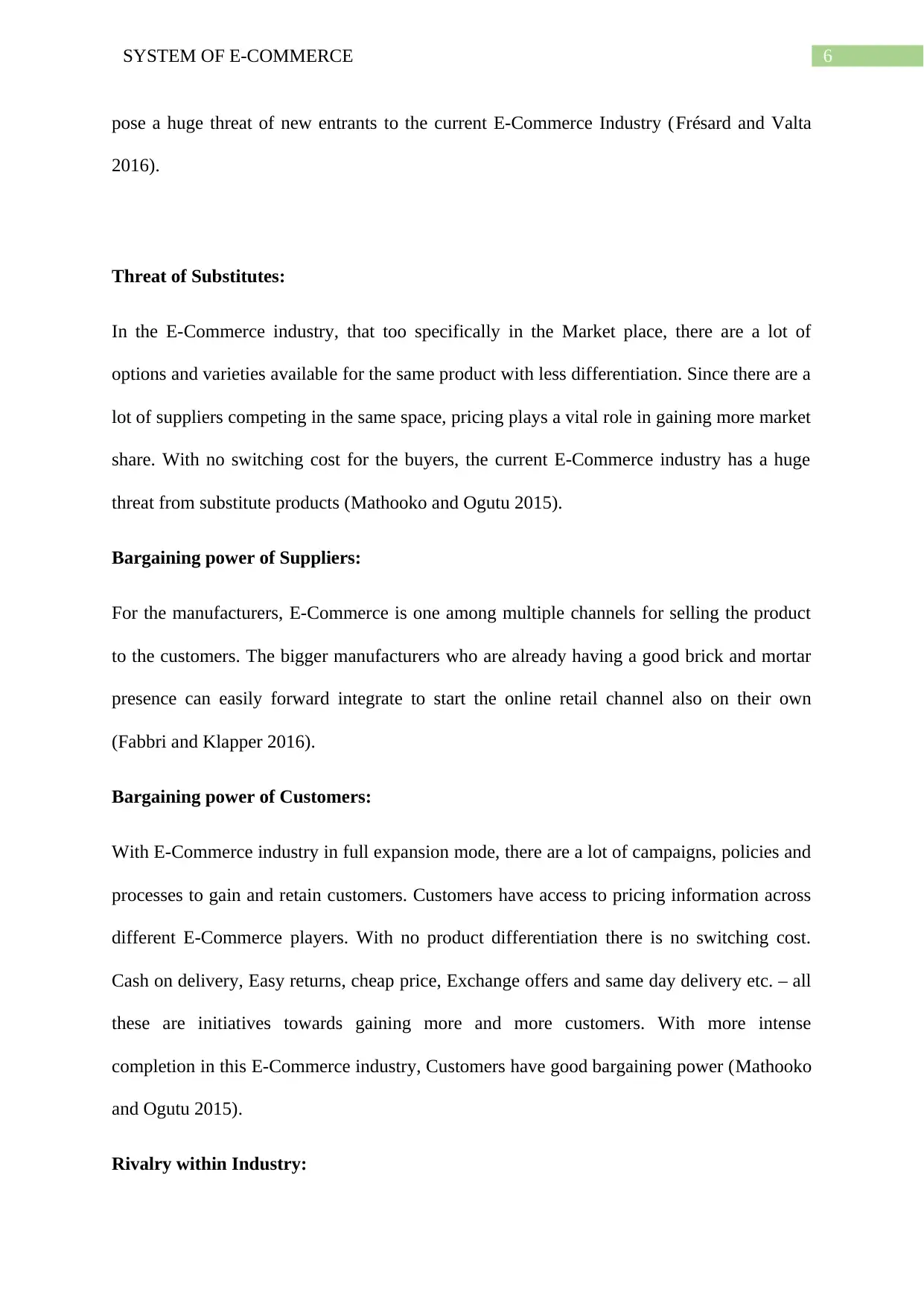
6SYSTEM OF E-COMMERCE
pose a huge threat of new entrants to the current E-Commerce Industry (Frésard and Valta
2016).
Threat of Substitutes:
In the E-Commerce industry, that too specifically in the Market place, there are a lot of
options and varieties available for the same product with less differentiation. Since there are a
lot of suppliers competing in the same space, pricing plays a vital role in gaining more market
share. With no switching cost for the buyers, the current E-Commerce industry has a huge
threat from substitute products (Mathooko and Ogutu 2015).
Bargaining power of Suppliers:
For the manufacturers, E-Commerce is one among multiple channels for selling the product
to the customers. The bigger manufacturers who are already having a good brick and mortar
presence can easily forward integrate to start the online retail channel also on their own
(Fabbri and Klapper 2016).
Bargaining power of Customers:
With E-Commerce industry in full expansion mode, there are a lot of campaigns, policies and
processes to gain and retain customers. Customers have access to pricing information across
different E-Commerce players. With no product differentiation there is no switching cost.
Cash on delivery, Easy returns, cheap price, Exchange offers and same day delivery etc. – all
these are initiatives towards gaining more and more customers. With more intense
completion in this E-Commerce industry, Customers have good bargaining power (Mathooko
and Ogutu 2015).
Rivalry within Industry:
pose a huge threat of new entrants to the current E-Commerce Industry (Frésard and Valta
2016).
Threat of Substitutes:
In the E-Commerce industry, that too specifically in the Market place, there are a lot of
options and varieties available for the same product with less differentiation. Since there are a
lot of suppliers competing in the same space, pricing plays a vital role in gaining more market
share. With no switching cost for the buyers, the current E-Commerce industry has a huge
threat from substitute products (Mathooko and Ogutu 2015).
Bargaining power of Suppliers:
For the manufacturers, E-Commerce is one among multiple channels for selling the product
to the customers. The bigger manufacturers who are already having a good brick and mortar
presence can easily forward integrate to start the online retail channel also on their own
(Fabbri and Klapper 2016).
Bargaining power of Customers:
With E-Commerce industry in full expansion mode, there are a lot of campaigns, policies and
processes to gain and retain customers. Customers have access to pricing information across
different E-Commerce players. With no product differentiation there is no switching cost.
Cash on delivery, Easy returns, cheap price, Exchange offers and same day delivery etc. – all
these are initiatives towards gaining more and more customers. With more intense
completion in this E-Commerce industry, Customers have good bargaining power (Mathooko
and Ogutu 2015).
Rivalry within Industry:
Paraphrase This Document
Need a fresh take? Get an instant paraphrase of this document with our AI Paraphraser
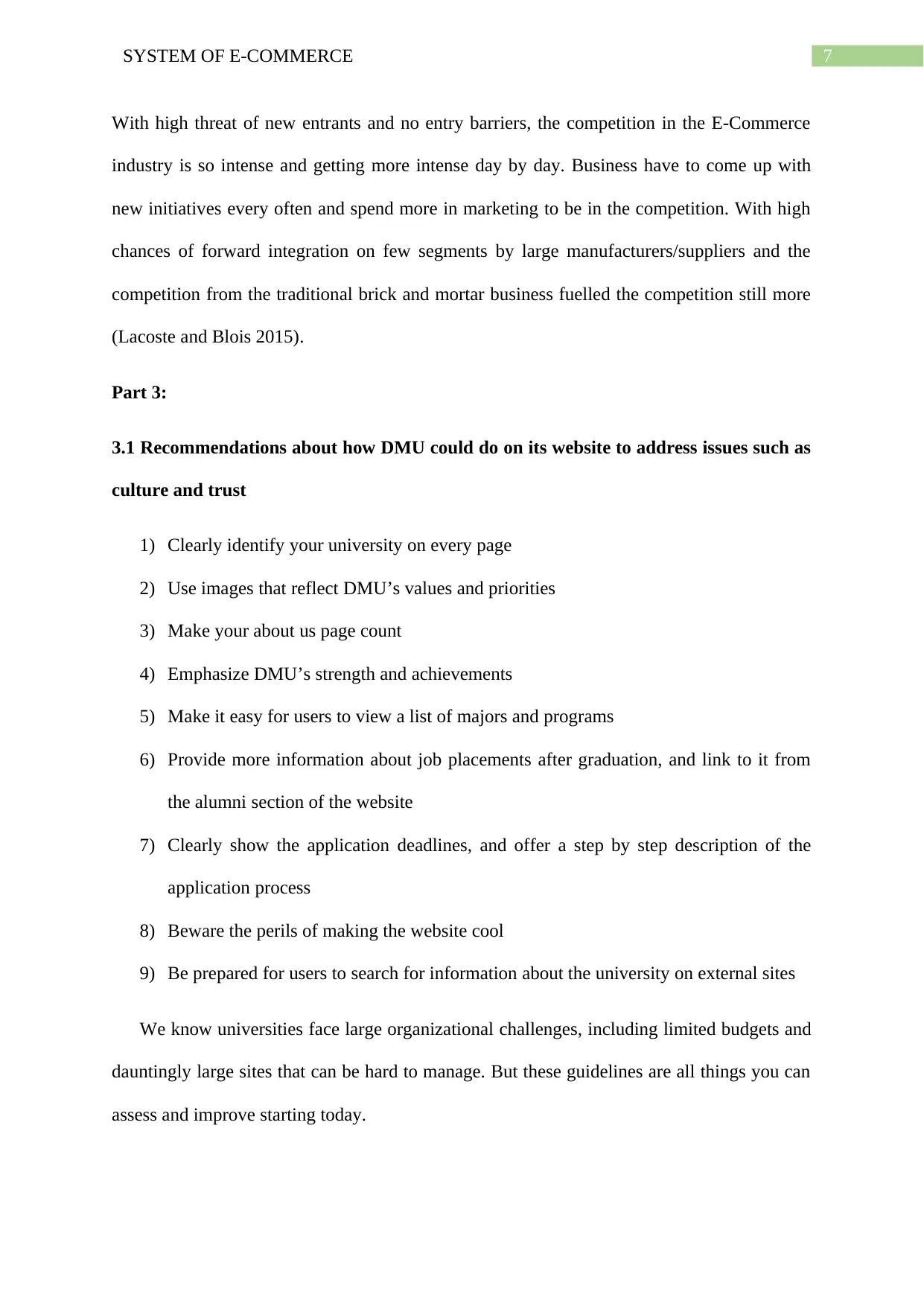
7SYSTEM OF E-COMMERCE
With high threat of new entrants and no entry barriers, the competition in the E-Commerce
industry is so intense and getting more intense day by day. Business have to come up with
new initiatives every often and spend more in marketing to be in the competition. With high
chances of forward integration on few segments by large manufacturers/suppliers and the
competition from the traditional brick and mortar business fuelled the competition still more
(Lacoste and Blois 2015).
Part 3:
3.1 Recommendations about how DMU could do on its website to address issues such as
culture and trust
1) Clearly identify your university on every page
2) Use images that reflect DMU’s values and priorities
3) Make your about us page count
4) Emphasize DMU’s strength and achievements
5) Make it easy for users to view a list of majors and programs
6) Provide more information about job placements after graduation, and link to it from
the alumni section of the website
7) Clearly show the application deadlines, and offer a step by step description of the
application process
8) Beware the perils of making the website cool
9) Be prepared for users to search for information about the university on external sites
We know universities face large organizational challenges, including limited budgets and
dauntingly large sites that can be hard to manage. But these guidelines are all things you can
assess and improve starting today.
With high threat of new entrants and no entry barriers, the competition in the E-Commerce
industry is so intense and getting more intense day by day. Business have to come up with
new initiatives every often and spend more in marketing to be in the competition. With high
chances of forward integration on few segments by large manufacturers/suppliers and the
competition from the traditional brick and mortar business fuelled the competition still more
(Lacoste and Blois 2015).
Part 3:
3.1 Recommendations about how DMU could do on its website to address issues such as
culture and trust
1) Clearly identify your university on every page
2) Use images that reflect DMU’s values and priorities
3) Make your about us page count
4) Emphasize DMU’s strength and achievements
5) Make it easy for users to view a list of majors and programs
6) Provide more information about job placements after graduation, and link to it from
the alumni section of the website
7) Clearly show the application deadlines, and offer a step by step description of the
application process
8) Beware the perils of making the website cool
9) Be prepared for users to search for information about the university on external sites
We know universities face large organizational challenges, including limited budgets and
dauntingly large sites that can be hard to manage. But these guidelines are all things you can
assess and improve starting today.
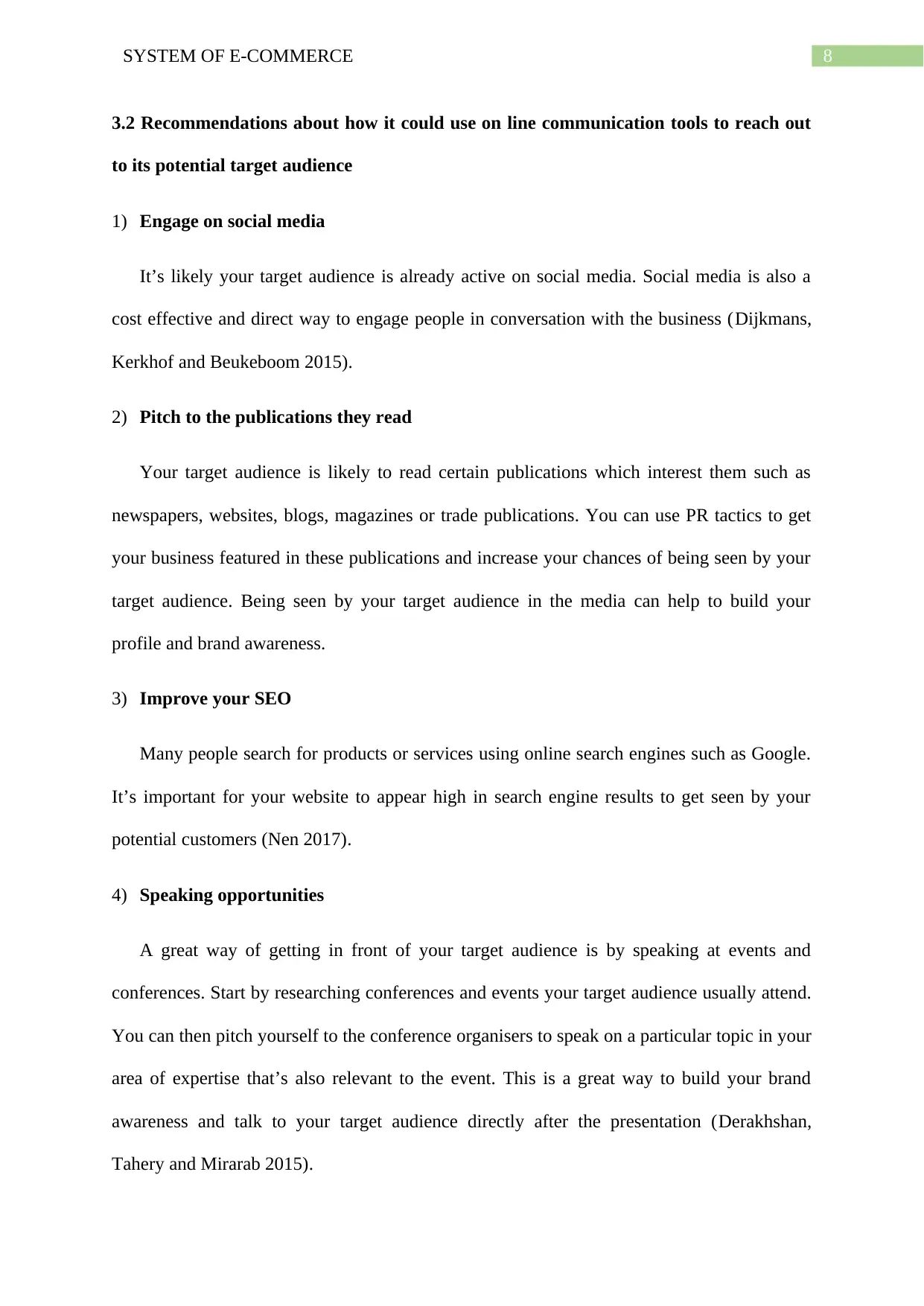
8SYSTEM OF E-COMMERCE
3.2 Recommendations about how it could use on line communication tools to reach out
to its potential target audience
1) Engage on social media
It’s likely your target audience is already active on social media. Social media is also a
cost effective and direct way to engage people in conversation with the business (Dijkmans,
Kerkhof and Beukeboom 2015).
2) Pitch to the publications they read
Your target audience is likely to read certain publications which interest them such as
newspapers, websites, blogs, magazines or trade publications. You can use PR tactics to get
your business featured in these publications and increase your chances of being seen by your
target audience. Being seen by your target audience in the media can help to build your
profile and brand awareness.
3) Improve your SEO
Many people search for products or services using online search engines such as Google.
It’s important for your website to appear high in search engine results to get seen by your
potential customers (Nen 2017).
4) Speaking opportunities
A great way of getting in front of your target audience is by speaking at events and
conferences. Start by researching conferences and events your target audience usually attend.
You can then pitch yourself to the conference organisers to speak on a particular topic in your
area of expertise that’s also relevant to the event. This is a great way to build your brand
awareness and talk to your target audience directly after the presentation (Derakhshan,
Tahery and Mirarab 2015).
3.2 Recommendations about how it could use on line communication tools to reach out
to its potential target audience
1) Engage on social media
It’s likely your target audience is already active on social media. Social media is also a
cost effective and direct way to engage people in conversation with the business (Dijkmans,
Kerkhof and Beukeboom 2015).
2) Pitch to the publications they read
Your target audience is likely to read certain publications which interest them such as
newspapers, websites, blogs, magazines or trade publications. You can use PR tactics to get
your business featured in these publications and increase your chances of being seen by your
target audience. Being seen by your target audience in the media can help to build your
profile and brand awareness.
3) Improve your SEO
Many people search for products or services using online search engines such as Google.
It’s important for your website to appear high in search engine results to get seen by your
potential customers (Nen 2017).
4) Speaking opportunities
A great way of getting in front of your target audience is by speaking at events and
conferences. Start by researching conferences and events your target audience usually attend.
You can then pitch yourself to the conference organisers to speak on a particular topic in your
area of expertise that’s also relevant to the event. This is a great way to build your brand
awareness and talk to your target audience directly after the presentation (Derakhshan,
Tahery and Mirarab 2015).
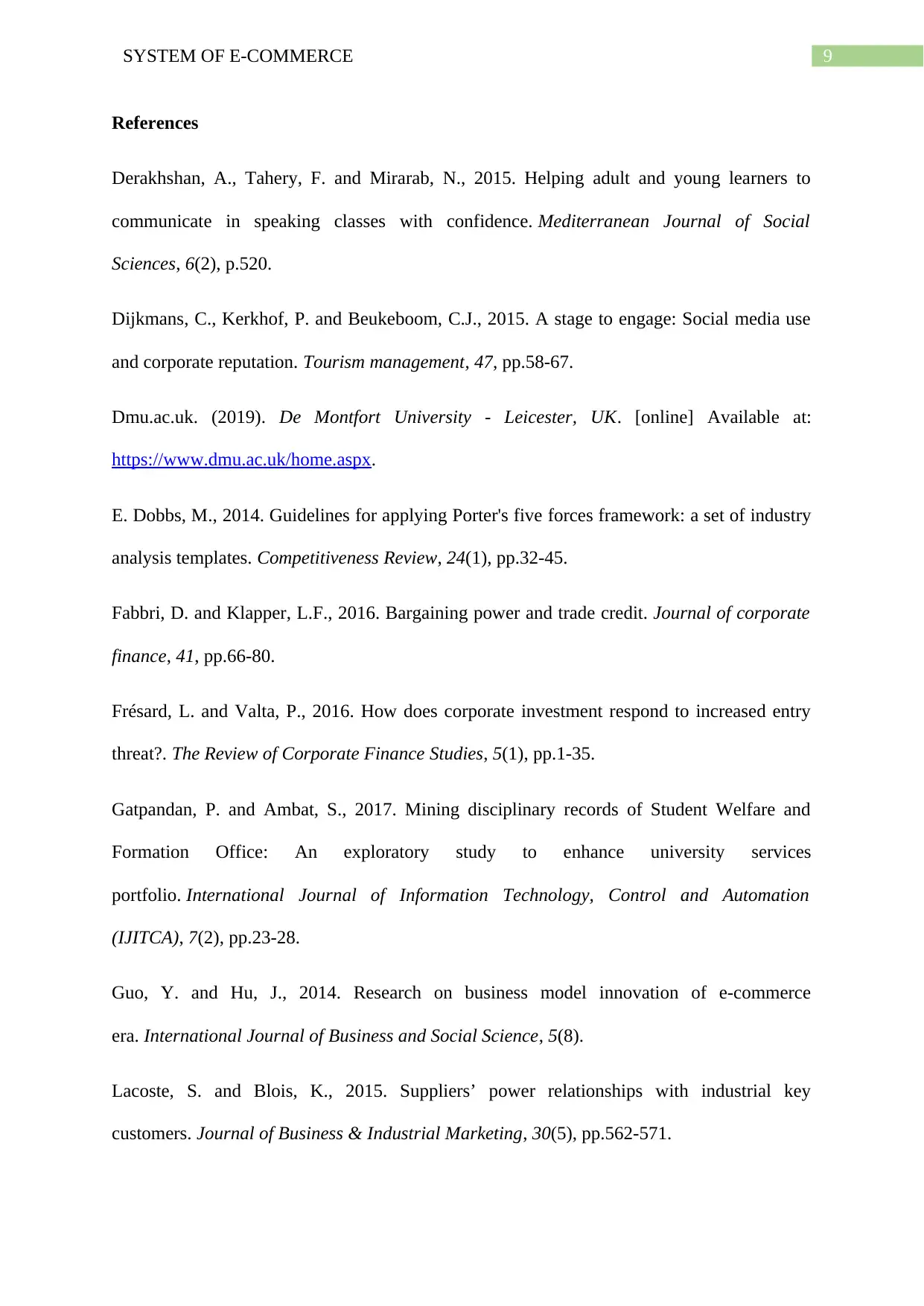
9SYSTEM OF E-COMMERCE
References
Derakhshan, A., Tahery, F. and Mirarab, N., 2015. Helping adult and young learners to
communicate in speaking classes with confidence. Mediterranean Journal of Social
Sciences, 6(2), p.520.
Dijkmans, C., Kerkhof, P. and Beukeboom, C.J., 2015. A stage to engage: Social media use
and corporate reputation. Tourism management, 47, pp.58-67.
Dmu.ac.uk. (2019). De Montfort University - Leicester, UK. [online] Available at:
https://www.dmu.ac.uk/home.aspx.
E. Dobbs, M., 2014. Guidelines for applying Porter's five forces framework: a set of industry
analysis templates. Competitiveness Review, 24(1), pp.32-45.
Fabbri, D. and Klapper, L.F., 2016. Bargaining power and trade credit. Journal of corporate
finance, 41, pp.66-80.
Frésard, L. and Valta, P., 2016. How does corporate investment respond to increased entry
threat?. The Review of Corporate Finance Studies, 5(1), pp.1-35.
Gatpandan, P. and Ambat, S., 2017. Mining disciplinary records of Student Welfare and
Formation Office: An exploratory study to enhance university services
portfolio. International Journal of Information Technology, Control and Automation
(IJITCA), 7(2), pp.23-28.
Guo, Y. and Hu, J., 2014. Research on business model innovation of e-commerce
era. International Journal of Business and Social Science, 5(8).
Lacoste, S. and Blois, K., 2015. Suppliers’ power relationships with industrial key
customers. Journal of Business & Industrial Marketing, 30(5), pp.562-571.
References
Derakhshan, A., Tahery, F. and Mirarab, N., 2015. Helping adult and young learners to
communicate in speaking classes with confidence. Mediterranean Journal of Social
Sciences, 6(2), p.520.
Dijkmans, C., Kerkhof, P. and Beukeboom, C.J., 2015. A stage to engage: Social media use
and corporate reputation. Tourism management, 47, pp.58-67.
Dmu.ac.uk. (2019). De Montfort University - Leicester, UK. [online] Available at:
https://www.dmu.ac.uk/home.aspx.
E. Dobbs, M., 2014. Guidelines for applying Porter's five forces framework: a set of industry
analysis templates. Competitiveness Review, 24(1), pp.32-45.
Fabbri, D. and Klapper, L.F., 2016. Bargaining power and trade credit. Journal of corporate
finance, 41, pp.66-80.
Frésard, L. and Valta, P., 2016. How does corporate investment respond to increased entry
threat?. The Review of Corporate Finance Studies, 5(1), pp.1-35.
Gatpandan, P. and Ambat, S., 2017. Mining disciplinary records of Student Welfare and
Formation Office: An exploratory study to enhance university services
portfolio. International Journal of Information Technology, Control and Automation
(IJITCA), 7(2), pp.23-28.
Guo, Y. and Hu, J., 2014. Research on business model innovation of e-commerce
era. International Journal of Business and Social Science, 5(8).
Lacoste, S. and Blois, K., 2015. Suppliers’ power relationships with industrial key
customers. Journal of Business & Industrial Marketing, 30(5), pp.562-571.
Secure Best Marks with AI Grader
Need help grading? Try our AI Grader for instant feedback on your assignments.
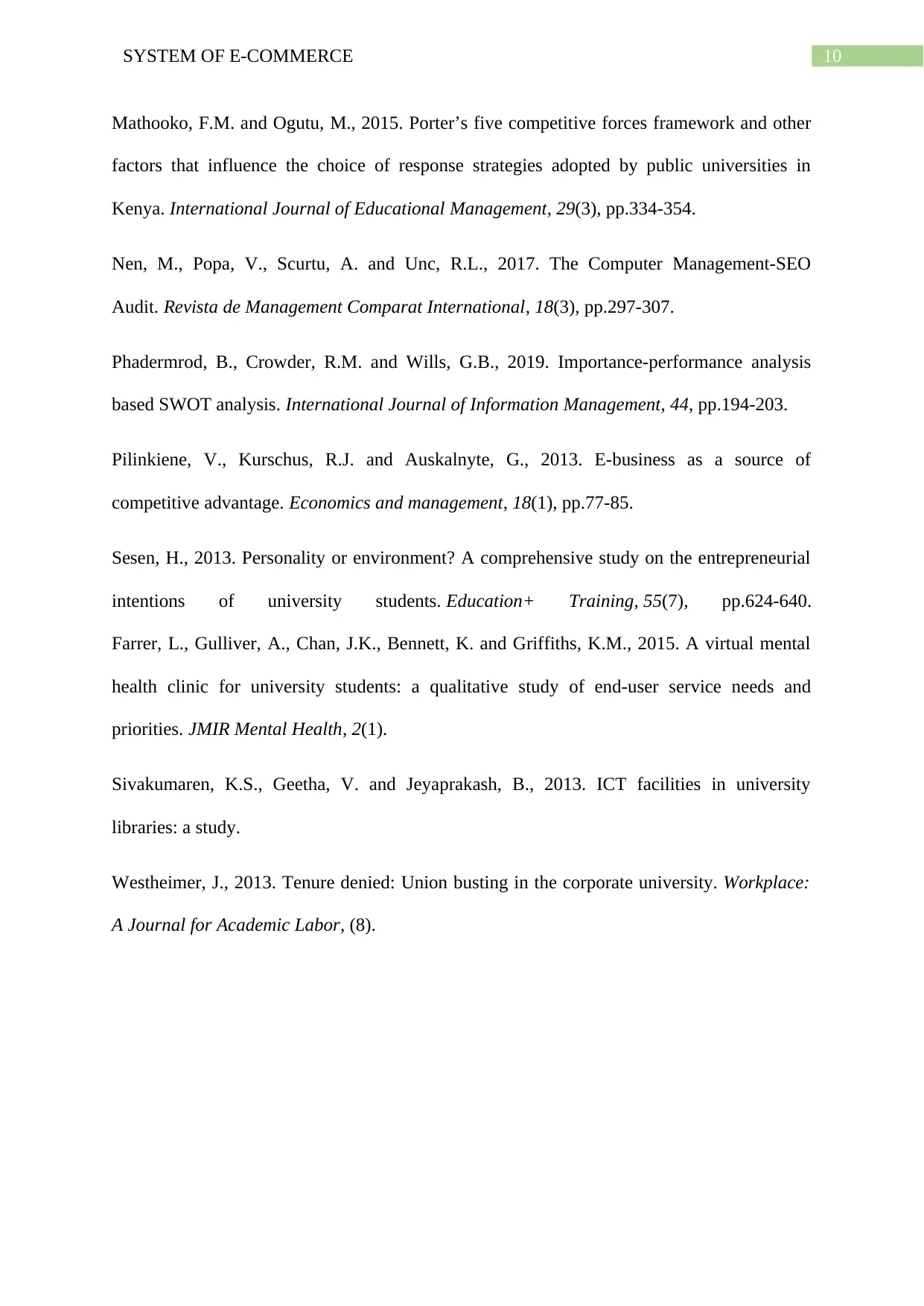
10SYSTEM OF E-COMMERCE
Mathooko, F.M. and Ogutu, M., 2015. Porter’s five competitive forces framework and other
factors that influence the choice of response strategies adopted by public universities in
Kenya. International Journal of Educational Management, 29(3), pp.334-354.
Nen, M., Popa, V., Scurtu, A. and Unc, R.L., 2017. The Computer Management-SEO
Audit. Revista de Management Comparat International, 18(3), pp.297-307.
Phadermrod, B., Crowder, R.M. and Wills, G.B., 2019. Importance-performance analysis
based SWOT analysis. International Journal of Information Management, 44, pp.194-203.
Pilinkiene, V., Kurschus, R.J. and Auskalnyte, G., 2013. E-business as a source of
competitive advantage. Economics and management, 18(1), pp.77-85.
Sesen, H., 2013. Personality or environment? A comprehensive study on the entrepreneurial
intentions of university students. Education+ Training, 55(7), pp.624-640.
Farrer, L., Gulliver, A., Chan, J.K., Bennett, K. and Griffiths, K.M., 2015. A virtual mental
health clinic for university students: a qualitative study of end-user service needs and
priorities. JMIR Mental Health, 2(1).
Sivakumaren, K.S., Geetha, V. and Jeyaprakash, B., 2013. ICT facilities in university
libraries: a study.
Westheimer, J., 2013. Tenure denied: Union busting in the corporate university. Workplace:
A Journal for Academic Labor, (8).
Mathooko, F.M. and Ogutu, M., 2015. Porter’s five competitive forces framework and other
factors that influence the choice of response strategies adopted by public universities in
Kenya. International Journal of Educational Management, 29(3), pp.334-354.
Nen, M., Popa, V., Scurtu, A. and Unc, R.L., 2017. The Computer Management-SEO
Audit. Revista de Management Comparat International, 18(3), pp.297-307.
Phadermrod, B., Crowder, R.M. and Wills, G.B., 2019. Importance-performance analysis
based SWOT analysis. International Journal of Information Management, 44, pp.194-203.
Pilinkiene, V., Kurschus, R.J. and Auskalnyte, G., 2013. E-business as a source of
competitive advantage. Economics and management, 18(1), pp.77-85.
Sesen, H., 2013. Personality or environment? A comprehensive study on the entrepreneurial
intentions of university students. Education+ Training, 55(7), pp.624-640.
Farrer, L., Gulliver, A., Chan, J.K., Bennett, K. and Griffiths, K.M., 2015. A virtual mental
health clinic for university students: a qualitative study of end-user service needs and
priorities. JMIR Mental Health, 2(1).
Sivakumaren, K.S., Geetha, V. and Jeyaprakash, B., 2013. ICT facilities in university
libraries: a study.
Westheimer, J., 2013. Tenure denied: Union busting in the corporate university. Workplace:
A Journal for Academic Labor, (8).
1 out of 11
Related Documents
Your All-in-One AI-Powered Toolkit for Academic Success.
+13062052269
info@desklib.com
Available 24*7 on WhatsApp / Email
![[object Object]](/_next/static/media/star-bottom.7253800d.svg)
Unlock your academic potential
© 2024 | Zucol Services PVT LTD | All rights reserved.





